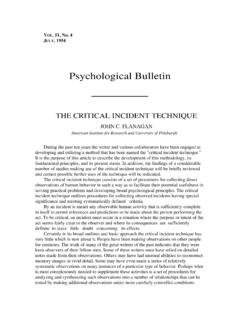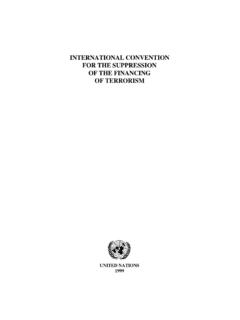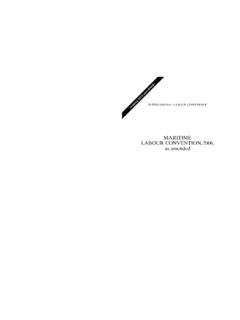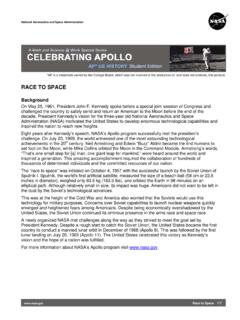Transcription of FAA-H-8083-16B; Chapter 2
1 Chapter 2. En Route Operations Introduction The en route phase of flight is defined as that segment of flight from the termination point of a departure procedure to the origination point of an arrival procedure. The procedures employed in the en route phase of flight are governed by a set of specific flight standards established by 14 CFR [Figure 2-1], FAA Order , and related publications. These standards establish courses to be flown, obstacle clearance criteria, minimum altitudes, navigation performance, and communications requirements.
2 2-1. fly along the centerline when on a Federal airway or, on routes other than Federal airways, along the direct course between NAVAIDs or fixes defining the route. The regulation allows maneuvering to pass well clear of other air traffic or, if in visual meteorogical conditions (VMC), to clear the flightpath both before and during climb or descent. Airways Airway routing occurs along pre-defined pathways called airways. [Figure 2-2] Airways can be thought of as three- dimensional highways for aircraft.
3 In most land areas of the world, aircraft are required to fly airways between the departure and destination airports. The rules governing airway routing, Standard Instrument Departures (SID). and Standard Terminal Arrival (STAR), are published flight procedures that cover altitude, airspeed, and requirements for entering and leaving the airway. Most airways are eight nautical miles (14 kilometers) wide, and the airway Figure 2-1. Code of Federal Regulations, Title 14 Aeronautics and Space. flight levels keep aircraft separated by at least 500 vertical En Route Navigation feet from aircraft on the flight level above and below when operating under VFR.
4 When operating under IFR, En route instrument flight rules (IFR) navigation is evolving between the surface and an altitude of Flight Level (FL). from the ground-based navigational aid (NAVAID) airway 290, no aircraft should come closer vertically than 1,000. system to a sophisticated satellite and computer-based feet. Above FL 290, no aircraft should come closer than system that can generate courses to suit the operational 2,000 feet except in airspace where Reduced Vertical requirements of almost any flight.
5 The FAA Global Separation Minima (RVSM) can be applied in which case Navigation Satellite System (GNSS) provides satellite-based the vertical separation is reduced to 1,000 feet. Airways positioning, navigation, and timing services in the United usually intersect at NAVAIDs that designate the allowed States to enable performance-based operations for all points for changing from one airway to another. Airways phases of flight, to include en route navigation. have names consisting of one or more letters followed by one or more digits ( , V484 or UA419).
6 14 CFR Part 91, , is the basis for the course to be flown. Unless authorized by ATC, to operate an aircraft The en route airspace structure of the National Airspace within controlled airspace under IFR, pilots must either System (NAS) consists of three strata. The first stratum low Figure 2-2. Airways depicted on an aeronautical chart. 2-2. altitude airways in the United States can be navigated Air Route Traffic Control Centers using NAVAIDs, have names that start with the letter V, and The FAA defines an Air Route Traffic Control Center (ARTCC).
7 Are called Victor Airways. [Figure 2-3] They cover altitudes as a facility established to provide air traffic control (ATC). from approximately 1,200 feet above ground level (AGL) service to aircraft operating on IFR flight plans within up to, but not including 18,000 feet above mean sea level controlled airspace, principally during the en route phase (MSL). The second stratum high altitude airways in the of flight. When equipment capabilities and controller United States all have names that start with the letter J, workload permit, certain advisory/assistance services may and are called Jet Routes.
8 [Figure 2-4] These routes run be provided to VFR aircraft. from 18,000 feet to 45,000 feet. The third stratum allows random operations above flight level (FL) 450. The altitude ARTCCs, usually referred to as Centers, are established separating the low and high airway structure varies from primarily to provide air traffic service to aircraft operating county to country. For example, in Switzerland it is 19,500 on IFR flight plans within the controlled airspace, and feet and 25,000 feet in Egypt. principally during the en route phase of flight.
9 There are Figure 2-3. Victor airways. Figure 2-4. Jet routes. Seattle Center ZSE ZMP. Minneapolis Center Boston Center ZLC ZBW. Salt Lake City Center ZAU ZOB. Chicago Center Cleveland Center ZNY. ZDV. Denver Center ZKC ZNY. ZOA Kansas City Center ZID New York Oakland Center Indianapolis Center Center ZDC. Washington Memphis Center Center (DC). Atlanta Center ZLA ZME. Los Angeles Center ZTL. ZAB. Albuquerque Center ZFW. Fort Worth Center ZJX. Houston Center Jacksonville Center ZHU. ZAN Miami Center Anchorage Center ZHN ZMA.
10 Honolulu Center Figure 2-5. Air Route Traffic Control Centers. 2-3. 21 ARTCC's in the United States. [Figure 2-5] Any aircraft operating under IFR within the confines of an ARTCC's airspace is controlled by air traffic controllers at the Center. This includes all sorts of different types of aircraft: privately owned single engine aircraft, commuter airlines, military jets, and commercial airlines. The largest component of the NAS is the ARTCC. Each ARTCC covers thousands of square miles encompassing all or part of several states.














